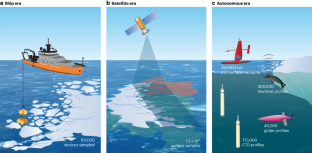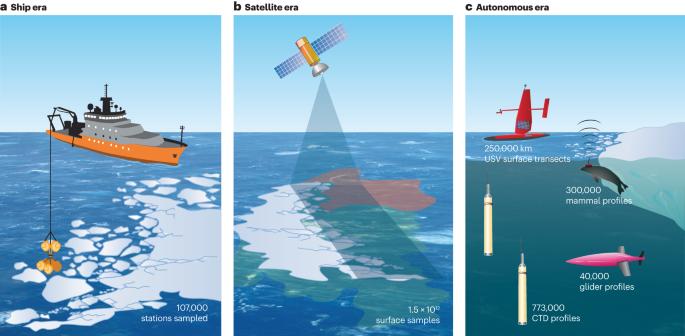The role of biota in the Southern Ocean carbon cycle
引用次数: 0
Abstract
The Southern Ocean, although relatively understudied owing to its harsh environment and geographical isolation, has been shown to contribute substantially to processes that drive the global carbon cycle. For example, phytoplankton photosynthesis transforms carbon dioxide into new particles and dissolved organic carbon. The magnitude of these transformations depends on the unique oceanographic and biogeochemical properties of the Southern Ocean. In this Review, we synthesize observations of biologically mediated carbon flows derived from the expanded observational network provided by remote-sensing and autonomous platforms. These observations reveal patterns in the magnitude of net primary production, including under-ice blooms and subsurface chlorophyll maxima. Basin-scale annual estimates of the planktonic contribution to the Southern Ocean carbon cycle can also be calculated, indicating that the export of biogenic particles and dissolved organic carbon to depth accounts for 20–30% (around 3 Gt yr–1) of the global export flux. This flux partially compensates for carbon dioxide outgassing following upwelling, making the Southern Ocean a 0.4–0.7 Gt C yr–1 sink. This export flux is surprisingly large given that phytoplankton are iron-limited with low productivity in more than 80% of the Southern Ocean. Solving such enigmas will require the development of four-dimensional regional observatories and the use of data-assimilation and machine-learning techniques to integrate datasets. The Southern Ocean represents a substantial carbon sink and heavily influences global carbon fluxes. This Review describes how an expanding suite of observations are providing increasing insight into the contribution of biota and plankton to the carbon cycle in the Southern Ocean.


生物群在南大洋碳循环中的作用
南大洋虽然因其环境恶劣和地理位置偏僻而研究相对不足,但已被证明对推动全球碳循环的过程做出了重大贡献。例如,浮游植物的光合作用将二氧化碳转化为新的颗粒和溶解的有机碳。这些转化的程度取决于南大洋独特的海洋学和生物地球化学特性。在这篇综述中,我们综合了通过遥感和自主平台提供的扩大观测网络对生物介导的碳流的观测结果。这些观测数据揭示了净初级生产量的模式,包括冰下水华和次表层叶绿素最大值。还可以计算出浮游生物对南大洋碳循环贡献的海盆尺度年度估计值,表明生物颗粒和溶解有机碳向深海的输出占全球输出通量的 20-30%(约 3 Gt yr-1)。这一通量部分补偿了上升流产生的二氧化碳排气,使南大洋成为每年 0.4-0.7 亿吨碳的吸收汇。鉴于南大洋 80% 以上的地区浮游植物受铁限制,生产力低下,这一输出通量之大令人惊讶。要解开这些谜团,需要建立四维区域观测站,并利用数据同化和机器学习技术整合数据集。
本文章由计算机程序翻译,如有差异,请以英文原文为准。
求助全文
约1分钟内获得全文
求助全文

 求助内容:
求助内容: 应助结果提醒方式:
应助结果提醒方式:


